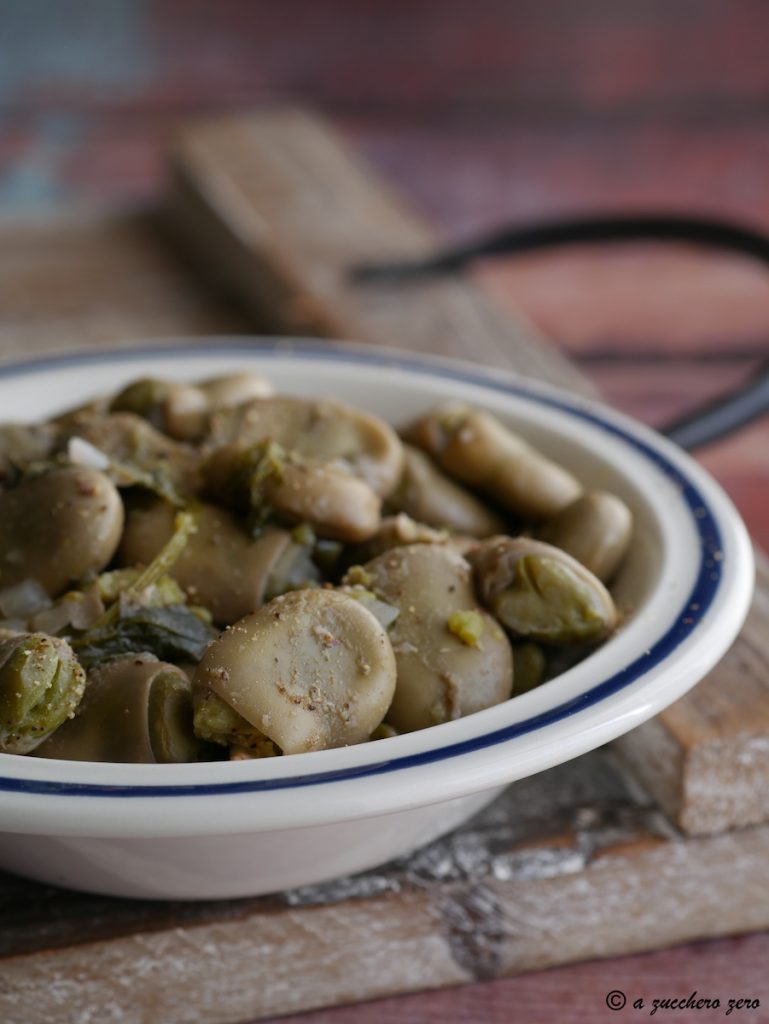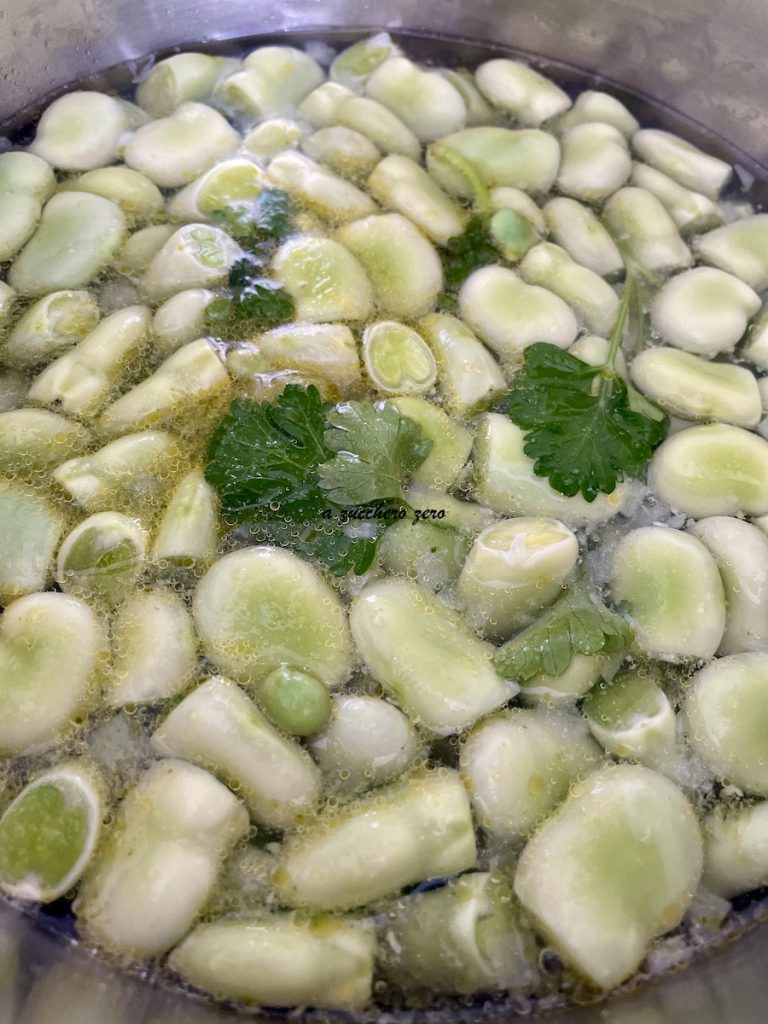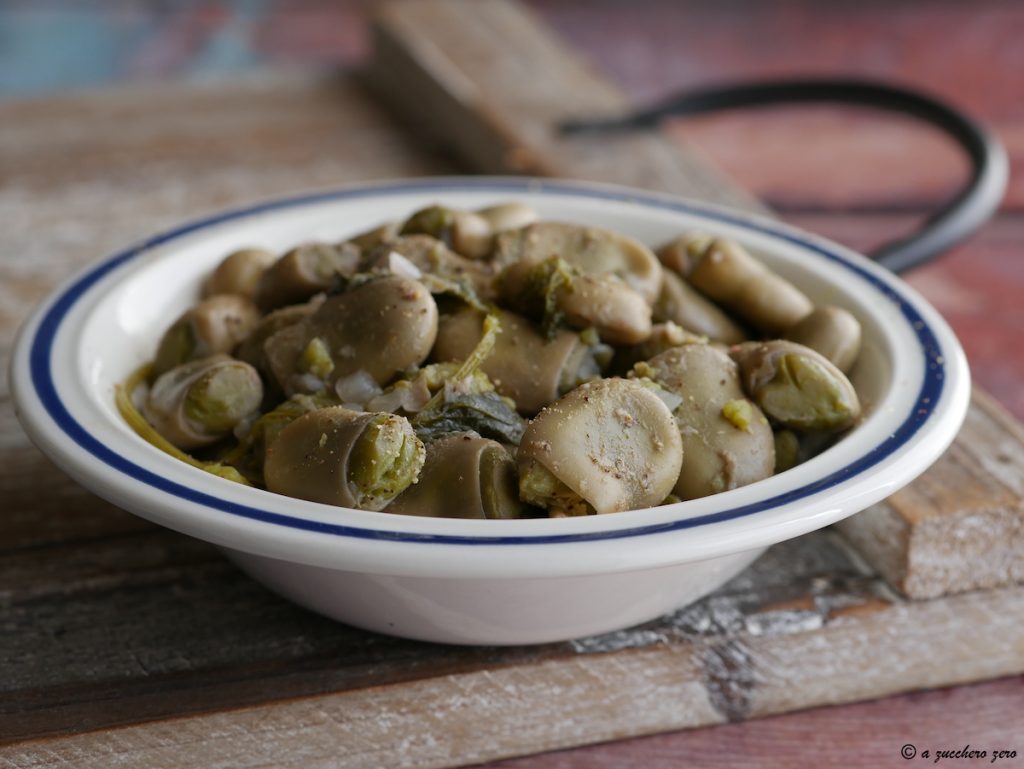The stewed pinched fresh fava beans, a typical dish of Sicilian tradition: Sicilian-style fava beans, are a basic recipe to be enjoyed as a soup or used to prepare spring appetizers, first and second courses.
The fresh fava beans are first pinched, meaning the top part of the skin is removed by taking off the stalk and leaving them slightly uncovered at the top.
Grandma Francesca pinched them with her fingers, with agility… I, less skilled, use a knife to cut off a small piece of the fava bean!
… after pinching them, the fava beans are cooked stewed.
It is better to use small and tender beans so that the skin is pleasant to eat; otherwise, in the case of large and tough beans, remove the skin if it’s too fibrous.
By prolonging the cooking of the beans, you get a kind of fresh fava bean puree which in Sicilian we call macco.
FAVA BEANS AND DIABETES
– Can diabetics eat fava beans?
The glycemic index of fava beans [GI 40] is higher than that of other legumes and also increases with cooking.
In the case of hyperglycemia, prediabetes, and diabetes, cooked fava beans should be consumed in moderation [always according to one’s dietary plan, ours includes them].
As suggested in general by Professor Enzo Bonora
It is important, in any case, in the presence of diabetes, to build an experience on the impact of this and all other foods on blood glucose. This means measuring before and two hours after eating it. Possibly more than once to have more reliable information. If the blood glucose increase is contained [less than 50 mg], you can put a “green light” on that type of food. Otherwise, it’s better to avoid it.

- Difficulty: Easy
- Cost: Medium
- Preparation time: 20 Minutes
- Portions: 2People
- Cooking methods: Stovetop
- Cuisine: Italian
Ingredients
Weight of fresh fava beans raw and cooked
From one kilogram of fresh fava beans [weight with pod] I obtained 375 g approximately of fresh fava beans [without pod].
- fresh fava beans (2 portions weight according to dietary plan)
- to taste onion
- 1 pinch garlic powder
- 2 tbsp water (+ to taste)
- 1 vegetable bouillon cube (homemade)
- 1 sprig parsley
- 1 pinch salt
- 1 pinch mixed peppercorns (with grinder)
- 1 drizzle extra virgin olive oil (raw)
Suggested Tools
- 1 Knife
- 1 Cutting Board
- 1 Braiser
Preparation
The guidelines for healthy eating report the following standard portions:
• fresh, soaked, or canned legumes 150 g;
• dried legumes 50 g.
⇒ remember that the weights are personal.
Remove the fresh fava beans from the pod.
“Pinch” the fava beans by removing the stalk and leaving them slightly uncovered at the top.
If you are not skilled at doing it with your fingers like grandmothers, use a knife to cut off a small piece of the fava bean!
Wash the fava beans under running water.Peel the onion, remove the ends, and wash it.
You can add it whole, halved, or chopped according to taste.In a braiser, heat a sprinkle of garlic powder.
Add the onion and let it wither for a few seconds.
Add 2 tablespoons of water and wait for it to fry.
Place the fava beans in the braiser and brown them.Add more water until it covers about a finger above the fava beans, a vegetable bouillon cube and the parsley.

Stew the fava beans for about 10 minutes, and if necessary, add more water.
Add salt and grind the pepper.
Continue cooking for 30 to 60 minutes over low heat, taking care to:
• check the consistency of the fava beans;
• add more water if needed;
• stir to avoid the fava beans sticking to the bottom of the braiser as they dry.The cooking time of fresh fava beans varies in relation to:
• the size and freshness of the fava beans;
• the desired consistency.Prolonging the cooking results in a kind of fresh fava bean puree which in Sicilian we call macco usually flavored with wild fennel.
Plate.
Grind a bit more pepper and drizzle with some extra virgin olive oil.Your stewed pinched fresh fava beans or stewed fava beans are ready.
Enjoy your meal!
Tips on Pairing Legumes
The pairing with pasta, rice, or other cereals allows you to better absorb the proteins of the legumes.
The cereals included in these dishes, in fact, compensate for the missing amino acids in the legumes, allowing you to obtain a complete amino acid pool.
Choose preferably whole grains.
For more insights: how to pair legumes in the diet.
FAQ (Frequently Asked Questions)
Can diabetics eat fava beans?
The glycemic index of fava beans [GI 40] is higher than that of other legumes and also increases with cooking.
In the case of hyperglycemia, prediabetes, and diabetes, cooked fava beans should be consumed in moderation [always according to one’s dietary plan, ours includes them].
As suggested in general by Professor Enzo Bonora
It is important, in any case, in the presence of diabetes, to build an experience on the impact of this and all other foods on blood glucose. This means measuring before and two hours after eating it. Possibly more than once to have more reliable information. If the blood glucose increase is contained [less than 50 mg], you can put a “green light” on that type of food. Otherwise, it’s better to avoid it.How to make fava beans more digestible?
It is better to use small and tender beans so that the skin is pleasant to eat; otherwise, in the case of large and tough beans, remove the skin if it’s too fibrous.
Prolonging the cooking of the fava beans results in a kind of puree.How to reduce the fiber of legumes?
It is better to use small and tender beans so that the skin is pleasant to eat; otherwise, in the case of large and tough beans, remove the skin if it’s too fibrous.
Prolonging the cooking of the fava beans results in a kind of puree.

